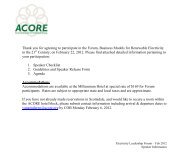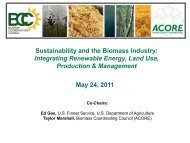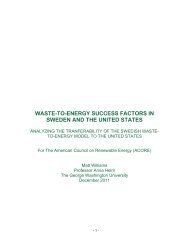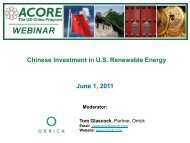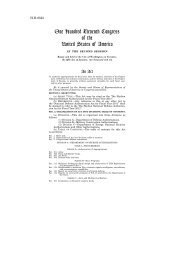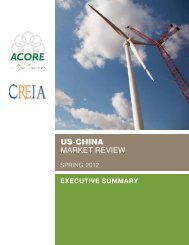Oregon is orienting much of its Stimulus Plan cash towardenergy efficiency, saving the state millions, while growingthe state’s renewable energy portfolio through a windtechnician training program, and business energy taxcredit that returns 35% of eligible project costs for projectsthat invest in energy conservation, recycling, renewableenergy resources, and less-polluting transportation fuels.Massachusetts: University Spinoffs toCommercial ViabilityIn 2008, Governor Deval Patrick signed the MassachusettsGreen Jobs Act, creating the Massachusetts Clean<strong>Energy</strong> Fund. The Fund provides grant money to stimulateclean energy companies, create green jobs, and providejob training programs to ensure all people have access tonew green jobs.The Fund’s Executive Director, Patrick Cloney, discussedMassachusetts’s approach to renewable energy development.Home to several high-profile research institutions,Massachusetts cannot provide large financial incentives,but it can shrink the growth calendar for companies, andfacilitate better communication between research andcommercial entities.Founded in 2004, the Massachusetts Technology TransferCenter is one of the state’s multiple business developmentprograms that help young research projects spin offinto private investment. Part of the Fund’s goals areaccelerating “ecosystem” interaction between entities ofvarious sizes, and navigating between municipalities.Some states have implemented economicdevelopment plans utilizing renewable energyresources.Texas: A Workforce BoomDoug Ridge, Director of Employer Initiatives with the TexasWorkforce Commission, spoke to the group about Texas’swind boom and the resultant “bump” in job creation, withsolar right behind. With more wind capacity than any otherUS state, growing at the rate of one utility-scale installationa week, it is no surprise that Texas’s renewableenergy workforce grew by 130% between 2000 and 2007.The resultant economic benefits revert not only to installers,but also to landowners and manufacturers.Kansas: A Rising Wind PowerhouseEnvisioning the manufacturing development a renewableenergy boom in Kansas would create, Lieutenant GovernorMark Parkinson of Kansas pointed out that 200,000turbines “means 200,000 generators, gearboxes, and600,000 blades,” a huge manufacturing opportunity.<strong>Renewable</strong> energy is an ecosystem. – PatrickCloney, Executive Director, Massachusetts Clean<strong>Energy</strong> FundKansas is increasingly realizing its huge wind capacity,going from 3 installed megawatts in 1997 to 365 megawattsin 2007.. In 2008, 900 MW were installed, and inJanuary 2009, alone, 1,000 more. To Parkinson,renewables can be scaled by regulators, making fossilpower artificially more expensive and green less so—or bynaturally achieving economies of scale in the marketplace.A national RPS is a difficult political proposition but wouldbe very effective, and subsidized research can help theprivate sector lower costs more rapidly.Economic Challenges<strong>Renewable</strong> energy markets continue to besensitive to volatility.Barriers exist for developers under uncertainenergy, credit, and carbon prices. It is moredifficult to evaluate the economic risks associatedwith various project ownerships and financialstructures under the current market state.The transmission of renewable energy fromremote generation facilities to higher densityload centers is one of the greatest challengeswe are facing.There are many economic barriers to large-scale renewableenergy adoption, not least of which is that of transmission.Transmission constraints limit the deliverycapacity for renewable energy, with new transmissionfacing high integration costs associated with accommodatinga large amount of intermittent resources.Changing supply dynamics play a critical role inthe renewable energy marketplace.Ethan Zindler of New <strong>Energy</strong> Finance spoke on thechanging market dynamics of the renewable energy world.The period between 2004 and 2007 saw historic, nowunderstood to be dangerous, amounts of leverage in the<strong>American</strong> <strong>Council</strong> <strong>On</strong> <strong>Renewable</strong> <strong>Energy</strong>Executive Summary Report 46
marketplace, accelerating and deepening the housingcrash. For renewables, the economic crisis of 2008-2009spells a transition from the equipment shortages endemicduring boom years that preceded it to supply-chain glut inthis climate of credit shortage. Supply of commoditiessuch as silicone have increased in the face of risingdemand, likely leading to great decreases in price.So how do we double renewable energy? The mostimportant action is policy implementation, especially theloan guarantee program, transmission permitting, and, toa lesser extent, the Stimulus Grant Program offered in lieuof the ITC. Also key to the health of the sector is newpolicy—whether it be an RES or carbon tax. Lastly, capitalavailability has to be present to see any substantialinvestments take off.Environmental Offsets andCreditsDeforestation is the second largest contributorto global carbon emissions behind only thepower generation industry.Founder of Canopy Capital Limited, MichaelNaylor conveyed that tropical rainforests cover1.2 billion hectares of land, an area larger thanEurope, and store a quarter of all the carbon onland. Every day, deforestation emits CO2 equivalentto 12.5 million people flying from New York toLondon. Tropical deforestation emits about 1.5billion tons of carbon each year—more than theentire global transport sector. Every year,deforestation emits the same amount of CO2 as580 mid-size coal-fired power stations, equivalent tothe total annual CO 2emissions of the US or China.Unless action is taken, the impact of forestemissions on climate change will cost around $1trillion a year by 2100.Carbon Financing and TradingThe current financial crisis is fosteringstructural, behavioral, and regulatory changes.Michael Zimmer of Thompson Hine LLPcalled for the financing of companies,innovation and technology–not just projects.Among other changes, internationaldiversification of industry is undermined, andtherefore many non-US markets have fallenworse than US markets. When liquidity is deepand credit available, developing economiesthrive. With such velocity and credit constraints,those developing markets fall harder. Look forvalues of risk modeling and ratings agencies todiminish in value. Sophisticated risk modelinghas experienced its downfall for derivatives,dynamic hedging. Consolidation in industry andfinancial sector concentration will become morepowerful. Loss of investment bank capacity,financial innovation and smaller, medium-sizedinstitutions will mean higher interest rates andfees. Financial concentration means differentscale, aversion to smaller projects like renewables,and increased conflicts of interest withcontinued price volatility. Managing multipleroles in securities underwriting, carbon trading,lending, investing, secondary market developmentand money management will prove daunting.The lack of a common <strong>American</strong> standardmakes defining an offset and following theguidelines set forth even more important.A carbon offset credit (or “offset”) is an instrumentreflecting the value of the direct reduction, avoidance orsequestration of a unit of carbon dioxide equivalent (CO 2e)that is generated from an unregulated sector or facility.Certain common attributes that define a high-value offset:• Additional – A project must not be required byany regulatory or legal mandate and shouldclearly be beyond “business as usual”.• Permanent – Emission reductions must bepermanent and appropriate contingenciesshould be instituted for sequestrationprojects that carry a risk of reversal.• Real – Tradable offset credits should only beawarded after emission reductions haveoccurred.• Verified – At inception, projects, baselines,and protocols should be reviewed andapproved by an independent third-party.<strong>American</strong> <strong>Council</strong> <strong>On</strong> <strong>Renewable</strong> <strong>Energy</strong>Executive Summary Report 47
- Page 6:
The highlights of WIREC 2008 includ
- Page 9 and 10: EVENT SPONSORSHosted byBadge Sponso
- Page 11 and 12: EXHIBITORS ContinuedKamatics Corp.K
- Page 13 and 14: The ARRA contains the following ite
- Page 15 and 16: “How do we organize ourselves to
- Page 17 and 18: John GeesmanFormer Commissioner, Ca
- Page 19 and 20: Cathy ZoiCEO, Alliance for Climate
- Page 21 and 22: John CavalierManaging Partner, Huds
- Page 23 and 24: BiofuelsChristopher Groobey, Partne
- Page 25 and 26: Patrick Cloney, Executive Director,
- Page 27 and 28: Gal Luft, Executive Director, Insti
- Page 29 and 30: Daniel Kammen, Class of 1935 Distin
- Page 31 and 32: Biomass, Biofuels, and Advanced Veh
- Page 33 and 34: Critical development opportunities
- Page 35 and 36: ConclusionsSpeakers at RETECH 2009
- Page 37 and 38: Geothermal PowerOverviewThe United
- Page 39 and 40: Green Buildings and CommunitiesOver
- Page 41 and 42: Green construction and renovation s
- Page 43 and 44: Session ReferencesGreen Schools Bre
- Page 45 and 46: 1. The local electric power market
- Page 47 and 48: International Renewable Energy Indu
- Page 49 and 50: production was 37%; the domestic tu
- Page 51 and 52: There have been a number of incenti
- Page 53 and 54: educes mortality and improves gende
- Page 55 and 56: D7 - ChinaJing Su, Director of US-C
- Page 57: past, uncertain legislative environ
- Page 61 and 62: • Complexity and operating costs
- Page 63 and 64: C6 - Environmental and Carbon Finan
- Page 65 and 66: The technology debate: thin film ve
- Page 67 and 68: FITs have grown in popularity over
- Page 69 and 70: Haroula Reitz, Global Manager of Sc
- Page 71 and 72: Currently, planning is geographical
- Page 73 and 74: Federal policy should allow for a c
- Page 75 and 76: Wind: Markets, Technologies, and Po
- Page 77 and 78: Regional FactorsBesides federal pol






